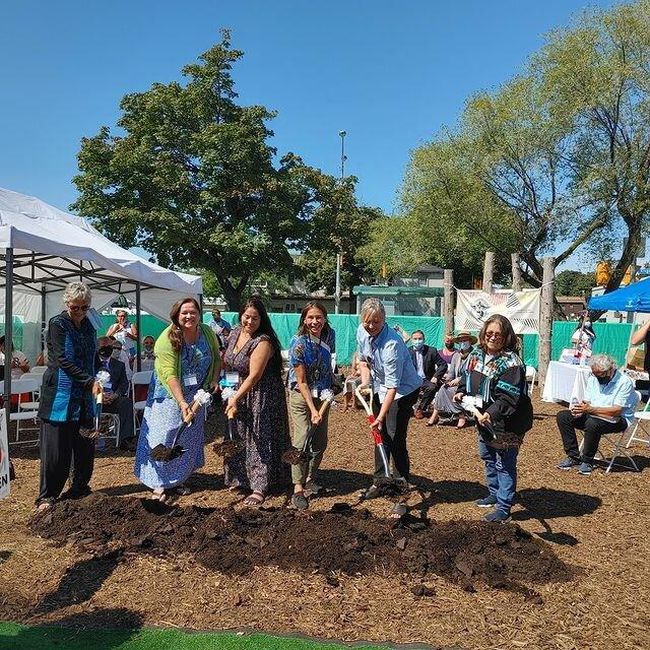Ever see a neat project in another city and wonder: could we do it here? Should we? We have too, and as part of an ongoing series we’ll be taking ideas from around the world and running them through the lens of Toronto.
Patti Pettigrew has seen how incorporating culture, community and identity into housing can be transformative.
Her organization, the Thunder Woman Healing Lodge Society, a non-profit that helps Indigenous women who have interacted with the law and those who have survived intergenerational trauma, currently rents a house in Toronto where seven women live.
The goal is to help the women living there feel whole within Indigenous culture and life through incorporating community practices.
“The cultural piece begins to feed your spirit. It increases your self-esteem and pride in who you are, and where you come from. Indigenous women will learn they have great value,” she said.
Culturally appropriate housing includes design that allows cultural identities to be maintained, passed down, created for communities and proceeding generations, according to a 2019 reports published by UBC and the Canadian Mortgage and Housing Corp.
It’s a movement that’s gained traction in New Zealand, as the country introduced a framework for housing quality in 2019 that involved integrating social and cultural sustainability into its plan.
They define this framework as “the degree to which housing design is flexible enough to respond to change in the specific physical, cultural, and social needs of individuals, families, and whānau” (meaning the extended family of traditional Māori people, who are the Indigenous Polynesian people of the mainland).
Culturally appropriate and safe housing is also a strategy taking root in Canada, with academics and community-led organizations like Thunder Woman advocating for its creation.
But without further support from the province and the federal government, and generally understanding from the public, these sites can take years to develop and it’s often left to Indigenous organizations to gather the funding together, or compete against each other for funding, academics and several leaders of housing organizations told the Star.
The house Pettigrew runs not only includes set times with councillors, it incorporates cultural teachings such as learning how to make drums and ribbon skirts, along with doing full moon ceremonies.
That’s why she received support from the City of Toronto to create more sites. Thunder Woman is building a six-storey healing lodge in Scarborough set to house 12 women that will be completed this year.
Another healing lodge location south of Chinatown is set to be completed by fall 2023 after the city announced a sublease agreement with Thunder Woman.
Housing stock in Canada often involves separate rooms, meant for each household member to keep to themselves, and have their own space. It’s catered to individuals, not a community, said Jose Wong, a development manager at BC housing who focused his graduate degree research on culturally relevant housing.
For many BIPOC groups whose way of life does not fit the mold of European-style housing — it can be jarring, said Wong
“(It’s) important because it mitigates the negative impacts of cultural shock, of immigrants, refugees and even First Nations that want access to housing,” he said.
the federal National Housing Strategy mentions the government will continue to work with First Nations groups to create a new policy framework to address housing concerns, but there are no specific mentions of cultural relevance in housing.
Cultural safety also extends to ensuring communities’ ways of life are protected in spaces like rental housing, said Katelyn Lucas, the executive director of the Elizabeth Fry Society in Calgary and the co-chair of the Aboriginal Standing Committee on Housing and Homelessness, a Calgary -based non-profit.
“(Indigenous people) are entering into binding agreements with landlords, and often things like our cultural ways of doing things, like smudging, or ceremony, or family constructs… it’s that lack of understanding,” she said.
And those who visit homes are considered to be family — not guests, and there’s often ignorance on how a family clan works, said Lucas. And cultural ceremonies that landlords are not aware of or look down upon can cause tension, she said.
In Toronto, the city’s HousingTO 2020-2030 Action Plan includes increasing culturally appropriate affordable and supportive housing for Indigenous communities.
“The city considers providing culturally safe and appropriate housing that is delivered by Indigenous organizations for Indigenous Peoples, a tangible step forward towards reconciliation,” said Valesa Faria, the housing secretariat for the city, in a statement to the Star.
But costs have increased due to inflation, which has means it’s taking more time to build everything, said Pettigrew, which is why she hopes other levels of government will be willing to support the projects.
“It is on everyone to invest (in cultural housing), it will only serve to benefit the society at large,” she said.
JOIN THE CONVERSATION
